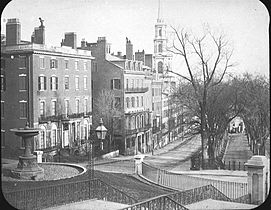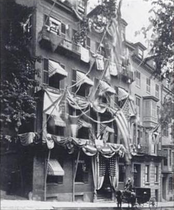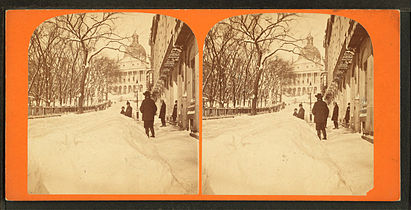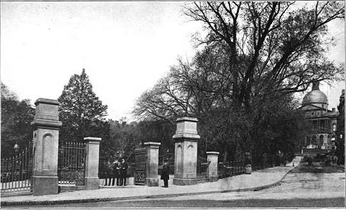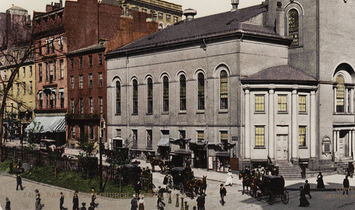
Boston Common is a central public park in downtown Boston, Massachusetts. It is sometimes erroneously referred to as the Boston Commons. Dating from 1634, it is the oldest city park in the United States. The Boston Common consists of 50 acres (20 ha) of land bounded by Tremont Street, Park Street, Beacon Street, Charles Street, and Boylston Street. The Common is part of the Emerald Necklace of parks and parkways that extend from the Common south to Franklin Park in Jamaica Plain, Roxbury, and Dorchester. A visitors' center for all of Boston is located on the Tremont Street side of the park.

Beacon Hill is a historic neighborhood in Boston, Massachusetts, and the hill upon which the Massachusetts State House resides. The term "Beacon Hill" is used locally as a metonym to refer to the state government or the legislature itself, much like Washington, D.C.'s "Capitol Hill" does at the federal level.
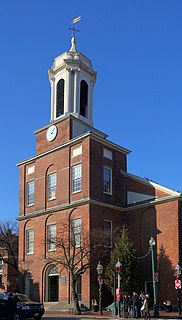
The Charles Street Meeting House is an early-nineteenth-century historic church in Beacon Hill at 70 Charles Street, Boston, Massachusetts.

Bowdoin Street in Boston, Massachusetts extends from the top of Beacon Street, down Beacon Hill to Cambridge Street, near the West End. It was originally called "Middlecott Street" as early as the 1750s. In 1805 it was renamed after the Governor James Bowdoin.

Tremont House, sometimes called the Tremont Hotel, was a hotel designed in 1829 by Isaiah Rogers in Boston, Massachusetts. Notable guests included Davy Crockett and Charles Dickens.
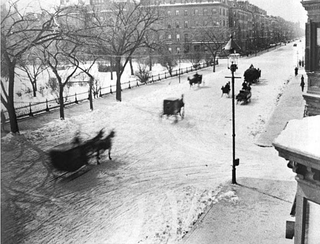
Beacon Street is a major thoroughfare in Boston, Massachusetts and its western suburbs Brookline and Newton. It passes through many of Boston's central and western neighborhoods, including Beacon Hill, Back Bay, Fenway–Kenmore, the Boston University campus, Brighton, and Chestnut Hill.

Tremont Street is a major thoroughfare in Boston, Massachusetts.

Charles Street is the name of a north-south street in the city center of Boston, Massachusetts. It begins in the north at Leverett Circle, where it connects with Nashua Street and Monsignor O'Brien Highway. Science Park station on the MBTA Green Line is located there. Charles Street runs south and gives its name to the Charles/MGH station on the MBTA Red Line, connecting via the Charles Circle rotary to Cambridge Street and the Longfellow Bridge which leads to Cambridge. This segment is a one-way street, with traffic heading northwards.

The Congregational Library & Archives is an independent special collections library and archives. It is located on the second floor of the Congregational House at 14 Beacon Street in the Beacon Hill neighborhood of Boston, Massachusetts. The Library was founded in 1853 by a gathering of Congregational ministers and has since evolved into a professional library and archives that holds more than 250,000 items, predominantly focused on 18th to 21st century American Congregational history. The Library's reading room is free and open to the public for research but the Library's stacks are closed and book borrowing privileges are extended exclusively to members.
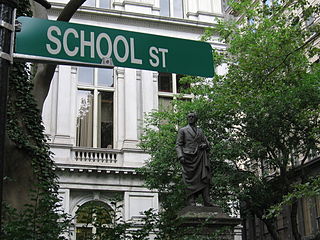
School Street is a short but significant street in the center of Boston, Massachusetts. It is so named for being the site of the first public school in the United States. The school operated at various addresses on the street from 1704 to 1844.

The Old Corner Bookstore is a historic commercial building located at 283 Washington Street at the corner of School Street in the historic core of Boston, Massachusetts. It was built in 1718 as a residence and apothecary shop, and first became a bookstore in 1828. The building is a designated site on Boston's Freedom Trail, Literary Trail, and Women's Heritage Trail.

The Park Street District is a historic district encompassing a small cluster of historic properties on or near Park Street in the heart of Boston, Massachusetts. The district covers an entire city block delineated by Park Street, Beacon Street, School Street, and Tremont Street, just east of the Boston Common. The district reflects an early design of the area by architect Charles Bulfinch, although only a few buildings from his period survive.

The Amory–Ticknor House is a historic house at 9–10 Park Street and 22–22A Beacon Street in Boston, Massachusetts. It was built in 1804 by businessman Thomas Coffin Amory, and later owned by scholar George Ticknor. It sits atop Beacon Hill, across from the Massachusetts State House on Beacon Street and the Boston Common on Park Street. Numerous tenants have occupied various parts of the house through the years, including Samuel Dexter, Christopher Gore, John Jeffries, Harrison Gray Otis, Anna Ticknor's Society to Encourage Studies at Home, and temporarily in 1824, the Marquis de Lafayette.
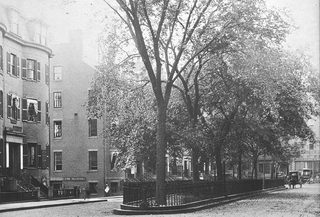
Pemberton Square in the Government Center area of Boston, Massachusetts, was developed by P.T. Jackson in the 1830s as an architecturally uniform mixed-use enclave surrounding a small park. In the mid-19th century both private residences and businesses dwelt there. The construction in 1885 of the massive John Adams Courthouse changed the scale and character of the square, as did the Center Plaza building in the 1960s.
This is a timeline of the history of the city of Boston, US.

Mount Vernon Church in Boston, Massachusetts, was a Congregational church located on Beacon Hill (1844–1891) and later in Back Bay (1892–present).
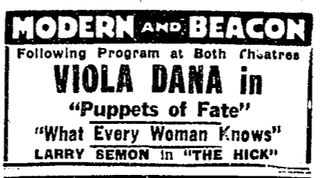
The Beacon Theatre was a cinema on Tremont Street in Boston, Massachusetts built in 1910 and closed in 1948. Jacob Lourie established it. Architect Clarence Blackall designed the building, with its 500-seat auditorium which a contemporary critic described as "showy." It had a staff of 26 in 1910. In 1948 the "refurbished" building became the Beacon Hill Theater. The building existed until 1970.


